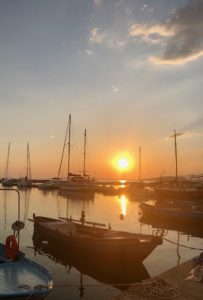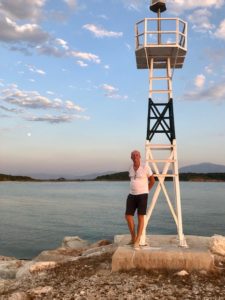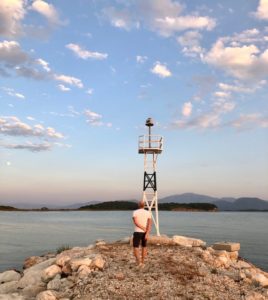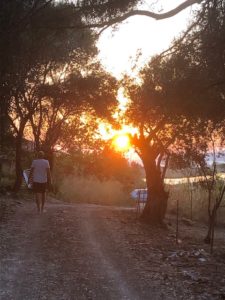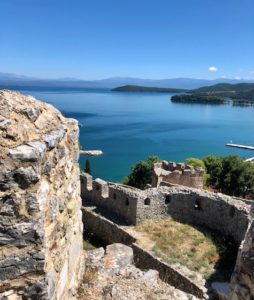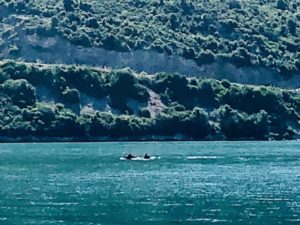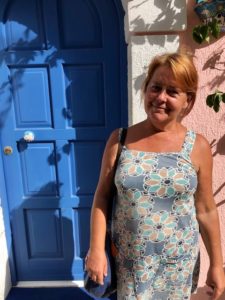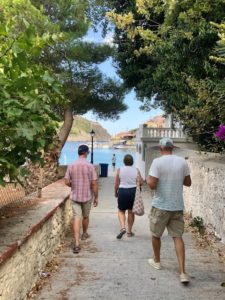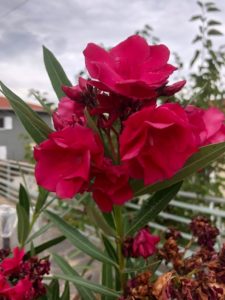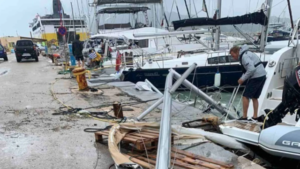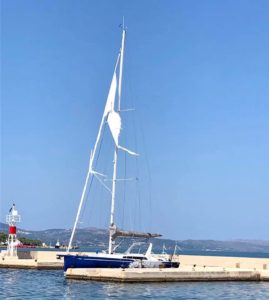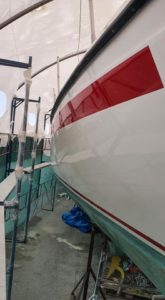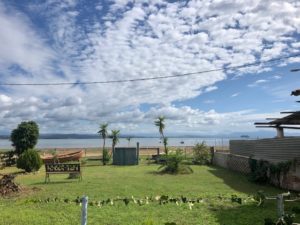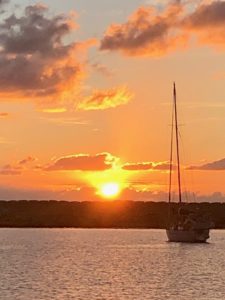Koronisia again
Vonitsa again
Ithaka


A visitor onboard

Strange fact– In ancient Rome the dormouse was considered a delicacy, either as an appetizer or as a dessert, dipped in honey and poppy seeds! 🥺They used a special kind of cage to raise and fatten them in-a gliarium-named after the mouse’s latin name Glis glis. In more recent years the dormice have begun to be kept as pets, especially in Asian countries, which of course is way better than being snacked upon! They can live for about five years which is quite a long time for a rodent.

Kefalonia

Together with them we rented a car and went around the island. Up and down the mountains on meandering and winding roads we went! We stopped for coffee in Assos, a small and charming fishing village with less than a hundred inhabitants. Situated on a narrow peninsula with the mountains looming up on one side and the clear blue sea on the other three sides it is the most isolated place on the island. Descending down from the mountains towards the village you have a stunning view over the whole peninsula and the old Venetian castle from 1570 that is guarding it! It is a lovely place💙
After the 1953 earthquake the village was totally destroyed but with the aid from the French that came here and helped the people rebuild their houses, the village could regain it’s traditional Ionian architecture. The village square is dedicated to the French and is known as Paris Square!
After Assos we continued to Fiskardo (or Fiscardo) at the northernmost tip of the island and just a short distance from Ithaka. Fiskardo is the only part of Kefalonia that was not destroyed in the 1953 earthquake, so it retains much of its original and very beautiful Venetian architecture with houses in bright and pretty pastel colors. This once small and unknown fishing harbor is now a very popular destination for the charter fleets so if you want to have a quiet lunch with a view over the sea, and not into somebody’s cockpit, this is probably not the place for you. At least not in high season. I think the best time for a visit here is in early spring or late autumn.
After a nice lunch we made ourselves ready for the next stop-The cavelake in Melissani also known as the Cave of the Nymphs- This is a beautiful underground lake with crystal clear water, between 10-39 m deep and partly open to the sky by a shaft 25 meters above. This secret lake was discovered in 1951 after a cave collapsed, revealing the lagoon below.
A cheerful and singing! man that also turned out to be a very fast shooting photographer, he probably took ten pictures in about 5 sec😂, was rowing us around the two chambers of the cave. It’s not a very big cave so it takes no more than approx. 10 min to row around it all, but it’s a very impressive place well worth a visit, and we even saw a big eel slowly passing by in the clear brackish water!
Medicane Ianos
It was now the 16th September and for a few days we had been aware of a Medicane (a Mediterranean hurricane) named Ianos that was moving in our direction.
The predictions were that it would be passing us by to the south of the neighboring island Zakynthos, but since you can never be sure with hurricanes we decided that, together with Andrew and Angela, we would go to an abandoned marina opposite of Argostoli town were we would be sheltered in a good way. Argostoli is actually situated in a bay within a bay and sheltered from the wind on three sides, so we deemed it to be the best place to be on Kefalonia, and the neighboring islands, in case Ianos decided to come closer. We could have sailed further north towards Lefkada but there are not so many good hidingplaces along the way and you don’t want to be hit by a hurricane out at sea.
There were not so many places left when we arrived at the Marina. More people had obviously had the same idea as us. Some of the locals were trying to move boats around and even sending them away so that they could get to the best spots! Some people!😡 But since this is an unfinished and abandoned Marina you can not reserve a place! There are no people working here, it’s just a few pontoons without any facilities. Rein and me really got angry, yelling at some people throwing the lines of a French ship in the water and trying to chase them away. By now we all knew that the Medicane had changed directions and was rapidly coming closer to us, which makes that kind of behavior even more despicable!
We are so grateful that we had our happy and lovely day out together with our friends because the very next day Ianos hit Kefalonia with full force and we actually ended up in the very eye of it. If you want to read more about our experience of the storm, I have written about this in the post below, but I will also mention something about it in this post.
The storm lasted for about three days with an enormous amount of rain and windspeed up to 105 knots (about 200 km/h or 54 m/s) This is a force you can not even begin to understand.
We were smashed on the concrete bridge and got some structural damage and then a boat in the marina came loose and headed directly toward us. If it had hit us at that moment Hoppetossa would probably have sunk. But it became stuck in something on the bottom and slowed down a lot so when it finally hit it was with considerably less force.
Our friends Andrew and Angela on their boat Millie were also hit. A motor yacht moored behind them barged into them several times and they have received quite a lot of damage, but luckily not below the waterline!

Update April 2021
Towards Kalamata…
It would take almost two weeks until we could trust the weather enough to leave Kefalonia. We needed a weather window of three to four days to get to Kalamata, and that amount of time is not so easy to find in the autumn. We would not sail, only go by engine in order to not strain the hull so much. While waiting we explored the town and together with Andrew and Angela we took the ferry over to Lixouri, Kefalonias second largest town after Argostoli.
We all liked it better than Argostoli. It is smaller and has a much more calm feeling to it. And the people from Lixouri are famous for being very polite, hospitable and professional singers! Who can resist that?😀

Lixouri, picture: Kefalonia by Anna
Loggerhead sea turtle in Argostoli harbor! They swim to the quayside every morning to get a free meal from the returning fishermen!
The 1:st of October our dear Millie’s left! They were going north to Preveza, where they had decided to take the ship up for repair. We are so happy that they were here with us during the hurricane! We have treated each other to dinner and drinks and been trying to cheer each other up. Having someone to talk to about what we have all been through together has also been a help to process it. Hopefully we’ll see them again next year!💚
The 7th October we could finally leave Argostoli to continue towards our winter harbor in Kalamata.
Good bye Kefalonia![]()
Our first stop was Katakolo, a small town that happens to be the nearest port when you want to go to Ancient Olympia 34 km away.
Kefalonia-A bit of history
I always get distracted in a myriad directions when I’m writing these Blogs. There are so much history and so many interesting stories, at least in my opinion😏 that it takes me for ever to finish the main post! Below are some information about two events that I feel are essential in the modern history of Kefalonia.
The Massacre of the Acqui Division 1943 also known as the Cephalonia Massacre
In WWII Greece was occupied by the Axis Powers (Germany, Italy, Japan) On Kefalonia the soldiers were mostly Italian, the 33d Infantry Division Acqui with about 12 000 men. But in Sep 1943 an armistice was signed between Italy and the Allies (UK, USA, The Soviet Union) and that of course changed everything! Germany moved fast, attacking and disarming the Italian army in Italy and in the occupied countries all over Europe.
On Kefalonia the Italian troops were hoping to return home, but when the German reinforcements arrived and tried to disarm them they took a vote with three alternatives-
- Join the Germans
- Surrender and be repatriated
- Resist the German forces
Eventually they decided to go with number 3 and resist as long as they could. The fighting ended in the siege of Argostoli where the Italians held out for a while but had to surrender when they ran out of ammunition.
A total of 1 315 Italians were killed in the battle, 5 155 were executed afterwards and about 3 000 were drowned when the German ships, taking the survivors to concentration camps, were sunk by the Allies. There are a lot of gruesome details about the massacre that I will not go into here. 37 of the 250 officers survived to tell the tale. How many of the soldiers that survived remains unclear. Suffice to say that this was one of the largest prisoner-of-war massacres and also one of many atrocities and war crimes committed by the German 1st Mountain Division (1 Gebirgs Division), an elite formation of the Wehrmacht.
General Hubert Lantz, Commander of the Mountain Corps, was sentenced to 12 years in prison at the Nuremberg Trials. He is the only one so far that has been prosecuted for the Cephalonia massacre. He was released in 1951 and died 1982. A strange circumstance that explains why Lantz got such a light sentence was that the court at Nuremberg was deceived by false evidence and could not state with any assurance that the massacre really took place. In spite of a lot of evidence and even lists of names of the victims, only ten ex-members of the 1st Gebirgs Division have been investigated, out of the 300 still alive today, but it has not resulted in any new arrests and time is now running out…
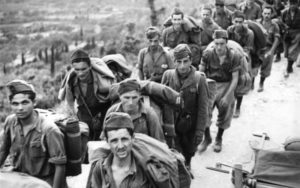
The book Captain Corelli’s Mandolin by Louis de Bernières, which was later made into a movie (with Nicolas Cage and Penelope Cruz) is based on this event.
While the war ended in central Europe in 1945 the Greek Civil War continued and peace returned to Greece and Kefalonia in 1949.




